Turkish tea holds a special place in our hearts and in the rich tapestry of Middle Eastern culture. This amber-colored elixir isn’t just a beverage – it’s a symbol of hospitality warmth and connection that brings people together around small tulip-shaped glasses throughout Turkey and beyond.
We’re about to share the authentic method for brewing this beloved drink using the traditional double-boiler system called a çaydanlık. This technique creates the perfect balance between strong concentrated tea and smooth diluted perfection that Turkish tea is famous for.
Whether you’re looking to recreate memories from Istanbul’s bustling bazaars or simply want to experience one of the industry’s most cherished tea traditions we’ll guide you through every step. Get ready to transform your kitchen into a Turkish tea house and discover why millions of people start their day with this comforting ritual that’s been perfected over centuries.
What Is Turkish Tea
Turkish tea represents far more than a simple beverage in our exploration of Middle Eastern traditions. We find ourselves discovering a cultural cornerstone that has shaped social interactions across Turkey for generations. This distinctive black tea preparation creates a unique drinking experience through its specialized brewing method and presentation.
The foundation of authentic Turkish tea lies in Rize tea leaves grown along Turkey’s Black Sea coast. These particular leaves develop their characteristic robust flavor from the region’s humid climate and fertile soil conditions. We recognize this tea variety as the essential component that distinguishes genuine Turkish tea from other black tea preparations worldwide.
Turkish tea achieves its signature taste profile through a two-tiered brewing system using the traditional çaydanlık. This method produces a concentrated tea essence in the upper pot while maintaining hot water in the lower vessel. We observe how this technique allows for customizable strength levels that accommodate individual preferences without compromising the tea’s fundamental character.
The serving ritual transforms Turkish tea into a social experience that extends beyond mere consumption. We notice how the distinctive tulip-shaped glasses enhance both the visual appeal and practical function of the drink. These clear vessels showcase the tea’s rich amber color while their narrow waist allows comfortable handling even though the hot liquid temperature.
Turkish tea culture emphasizes the balance between strength and smoothness in every cup. We appreciate how skilled tea preparers adjust the concentration by varying the ratio of tea essence to hot water. This flexibility ensures that each serving meets the drinker’s personal taste while maintaining the authentic Turkish tea experience that connects people across generations.
Essential Equipment for Making Turkish Tea
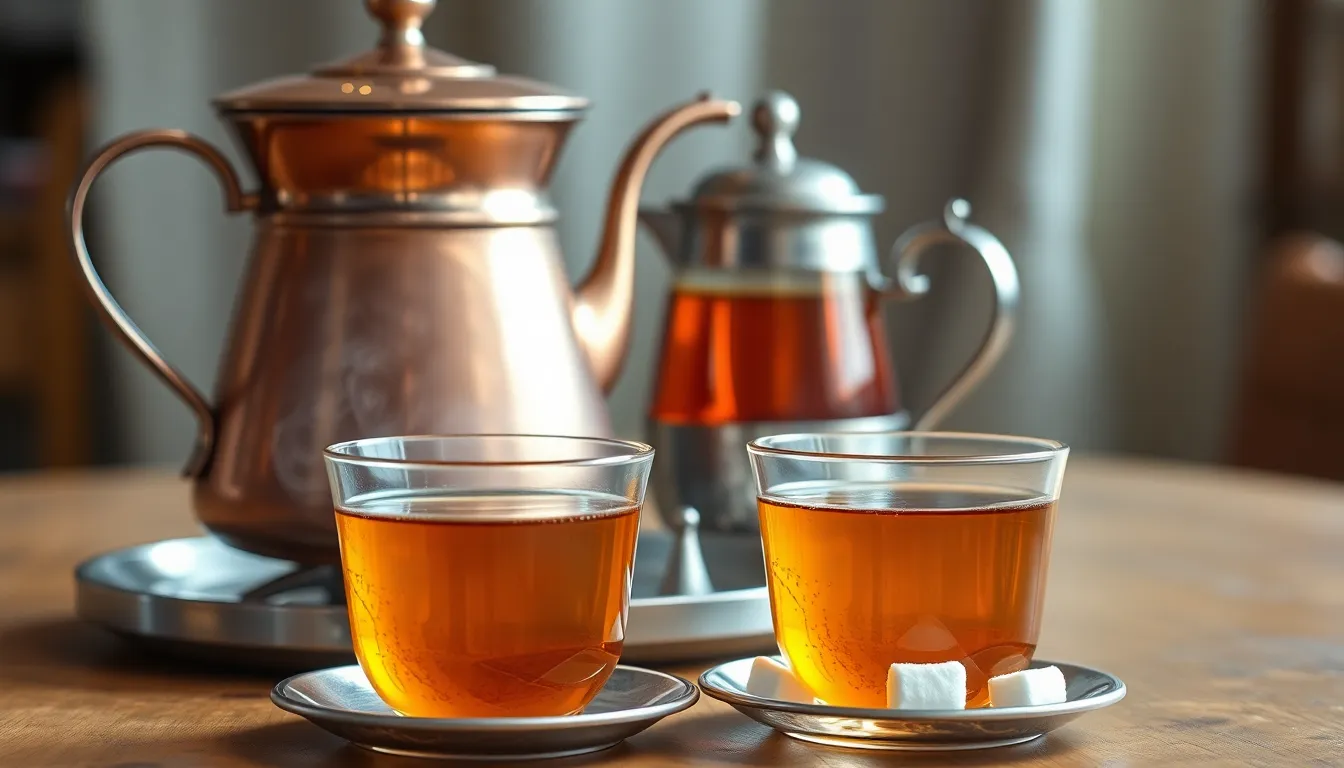
Creating authentic Turkish tea requires exact equipment that has been perfected over centuries of brewing tradition. We’ll explore both traditional and modern options to help you achieve the perfect cup.
Traditional Turkish Tea Set (Çaydanlık)
The çaydanlık serves as the heart of Turkish tea brewing and consists of two stacked kettles that work in perfect harmony. We fill the lower kettle with water for boiling while the upper kettle holds loose-leaf black tea that brews using steam from below. This ingenious design allows us to control tea strength precisely while keeping our brew warm throughout the day.
Traditional çaydanlık sets come in various materials that each offer unique benefits:
| Material | Benefits | Best For |
|---|---|---|
| Copper | Even heat distribution, classic appearance | Traditional brewing enthusiasts |
| Stainless Steel | Durability, easy maintenance | Daily use |
| Glass | Visual brewing process, modern aesthetic | Contemporary kitchens |
Tea glasses called “ince belli” complete the traditional setup with their distinctive tulip shape and narrow waist. These small glasses retain heat effectively while showcasing the tea’s vibrant amber color. We recommend serving them with matching saucers for sugar cubes or traditional cookies.
Alternative Equipment Options
Electric tea makers offer modern convenience while maintaining authentic brewing principles. These automated systems replicate the traditional double teapot method with programmable temperature controls and keep-warm functions. Many models feature settings for different tea types and automatic brewing cycles that take the guesswork out of timing.
We can also use standard teapots and kettles when a çaydanlık isn’t available. While this method works for basic tea preparation, it doesn’t provide the same level of strength control or heat retention that traditional equipment offers. The tea may cool more quickly and require more frequent reheating throughout the day.
Essential accessories remain consistent regardless of your brewing method. Tea filters help strain loose leaves while small sugar cubes and serving saucers maintain the cultural presentation that makes Turkish tea special.
Ingredients
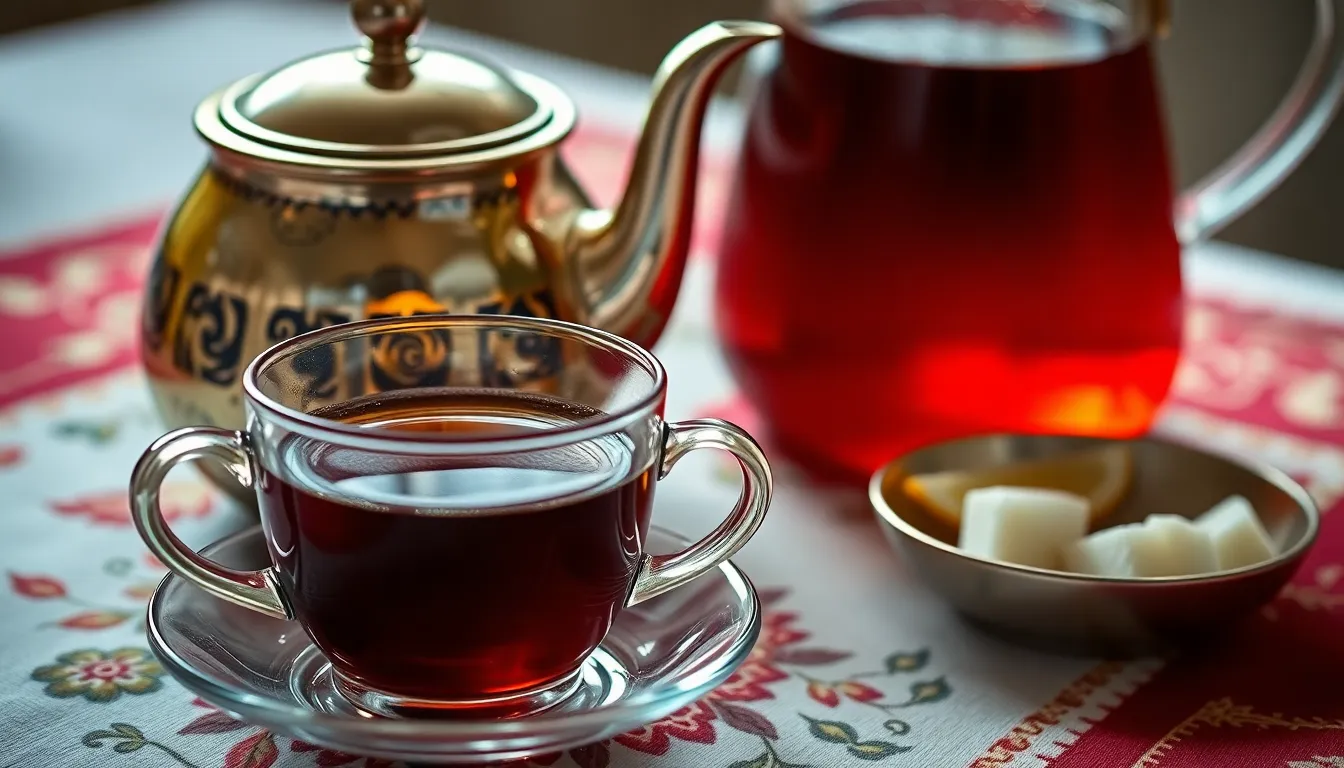
Creating authentic Turkish tea requires just a few essential ingredients, though the quality of each component makes a important difference in the final result. We focus on sourcing the best possible ingredients to honor this traditional brewing method.
For the Tea
- Turkish black tea leaves – 2-3 tablespoons of loose leaf Turkish tea, preferably sourced from the Black Sea region for the most authentic flavor
- Fresh water – 4-6 cups of high-quality water for optimal taste
- Sugar – Optional, according to individual preference for sweetening
Optional Accompaniments
- Sugar cubes or honey – Traditional sweetening options served alongside the tea
- Lemon slices – Occasionally offered as a citrus accompaniment
- Turkish delight (lokum) – Classic confection that pairs beautifully with tea
- Turkish cookies – Traditional biscuits that complete the authentic tea experience
- Cloves – For those who prefer a spiced variation
- Cinnamon sticks – Adds warmth and complexity to flavored versions
- Dried apple pieces – Popular addition for Turkish apple tea variations
Instructions
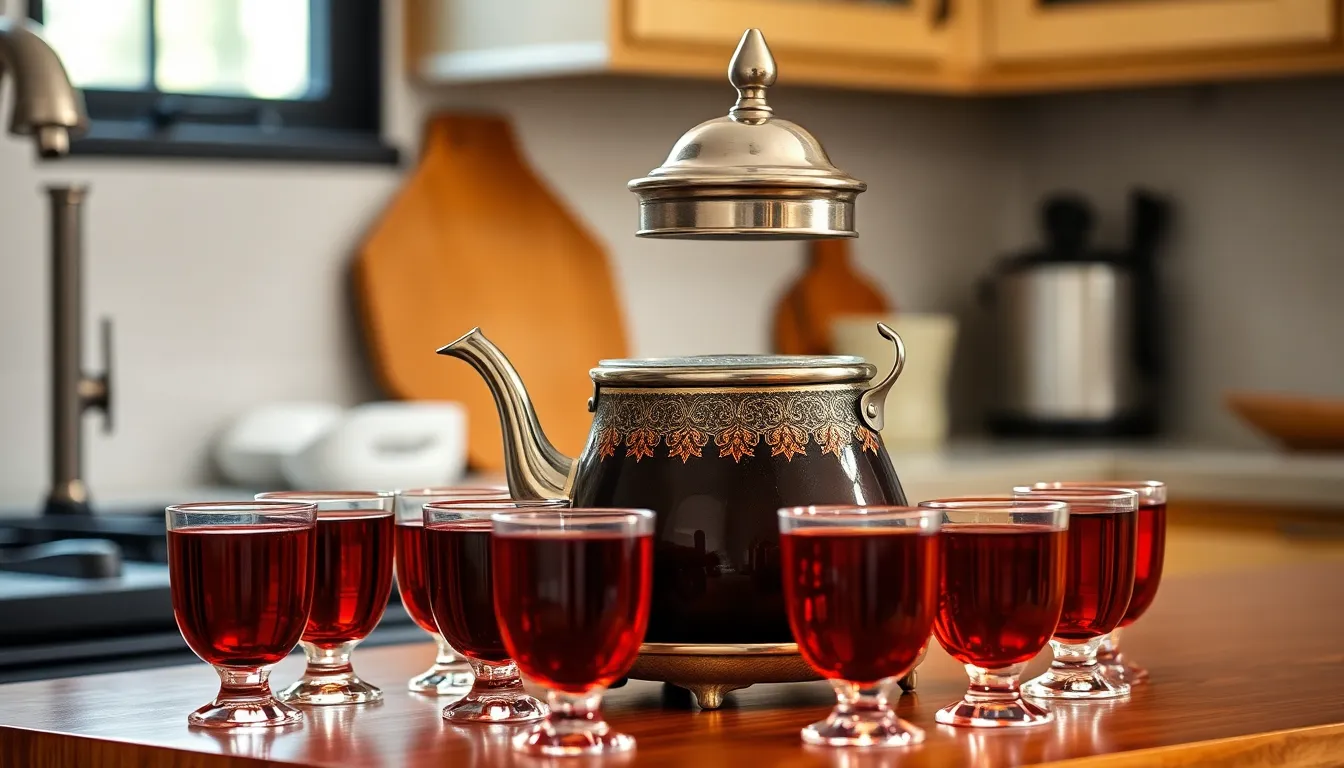
We’ll walk you through the traditional Turkish tea brewing process that creates the perfect balance of strength and smoothness. This time-honored method ensures every cup delivers the authentic taste that has defined Turkish hospitality for generations.
Preparing the Tea Setup
We begin by setting up our traditional Turkish tea pot set or double electric kettle. The çaydanlık consists of two essential components: a larger pot for boiling water and a smaller one positioned on top for brewing the tea leaves. Position the smaller pot directly on top of the larger one to create the classic double-tiered brewing system. This traditional setup allows us to maintain precise control over both water temperature and tea strength throughout the brewing process.
Boiling the Water
Fill the large pot completely with fresh water and place it on the stove over medium-high heat. Bring the water to a rolling boil while keeping the smaller pot positioned on top. Electric kettle users can alternatively boil water separately for quicker results. We maintain consistent heat to ensure the water reaches the optimal temperature for extracting the tea’s full flavor profile.
Adding the Tea Leaves
Measure one teaspoon of black tea leaves for each 100 mL glass we plan to serve. Place the measured tea leaves directly into the smaller pot of our Turkish tea set. The Black Sea region tea leaves provide the robust foundation essential for authentic Turkish tea. We distribute the leaves evenly across the bottom of the small pot to ensure uniform brewing.
The Double Brewing Method
Pour the boiling water from the large pot into the small pot until the tea leaves are completely covered. Return the small pot to its position on top of the large pot and reduce the heat to a gentle simmer. Allow the tea to brew for 10 to 15 minutes while the double-pot system maintains optimal temperature. Refill the large pot with additional water during this process to keep hot water available for serving and to maintain consistent heat transfer to the brewing tea above.
| Brewing Stage | Time | Temperature |
|---|---|---|
| Initial steeping | 10-15 minutes | Gentle simmer |
| Continuous heating | Throughout serving | Low heat |
Achieving the Perfect Color
Pour the concentrated tea from the small pot into tulip-shaped glasses until each glass is one-third to half full. Add hot water from the large pot to dilute the strong tea concentrate until we achieve a rich dark amber color. The perfect Turkish tea displays a beautiful reddish-brown hue that indicates proper brewing strength. We adjust the tea-to-water ratio based on individual preference while maintaining the characteristic deep color that defines authentic Turkish tea.
Serving Turkish Tea
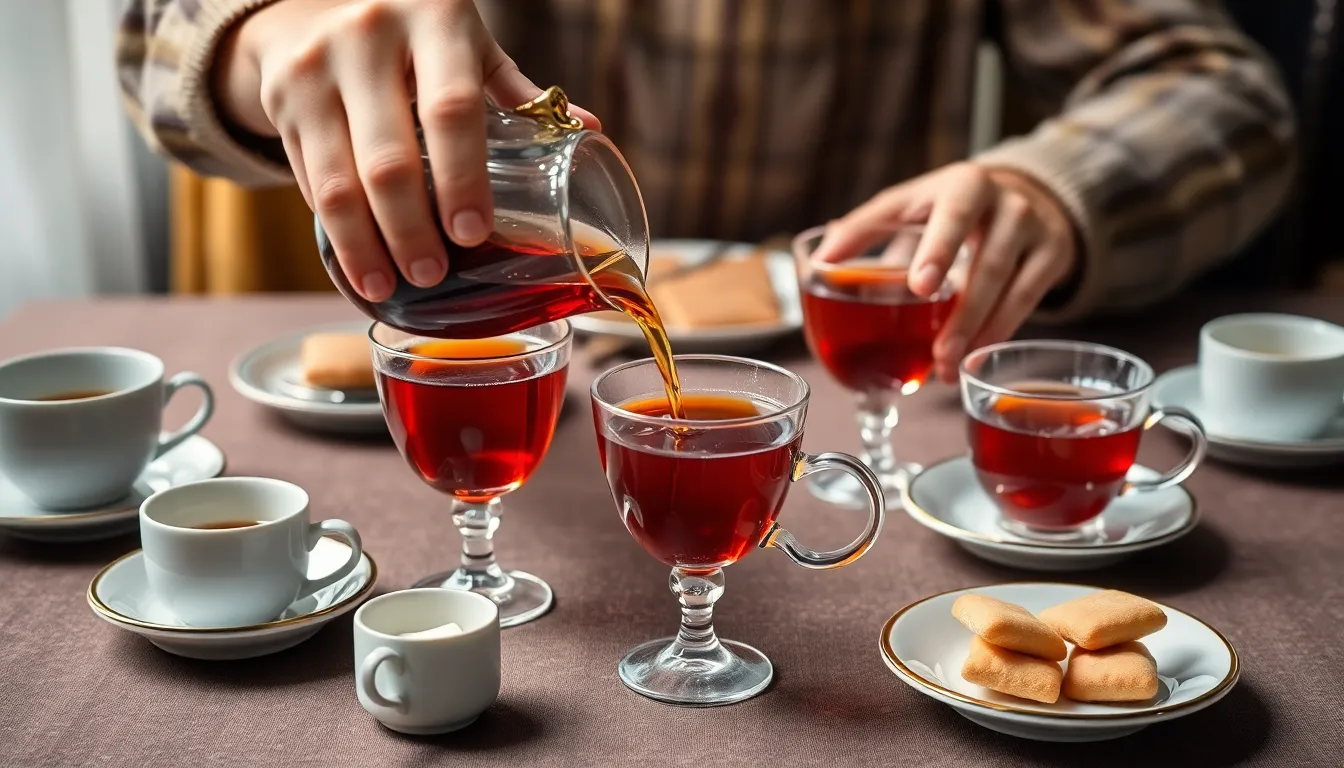
Turkish tea transforms from a brewing ritual into a meaningful social experience that marks the end of meals and begins heartfelt conversations. We honor this tradition by following exact serving customs that have been passed down through generations.
Traditional Tea Glasses
We serve Turkish tea in distinctive tulip-shaped glasses called “çay bardağı” that enhance both the visual appeal and functionality of our tea experience. These small glasses preserve the tea’s aroma and maintain its optimal temperature while we sip. The elegant shape allows us to appreciate the tea’s rich color while the narrow top concentrates the fragrant steam. We always place these glasses on matching saucers to complete the traditional presentation and protect surfaces from heat.
Proper Pouring Technique
We pour Turkish tea directly from the upper teapot of our çaydanlık into the waiting glasses with practiced precision. The double-kettle system allows us to control the tea’s strength by adjusting the ratio of concentrated tea from the top pot to hot water from the bottom pot. We fill each glass about two-thirds full to allow space for the tea’s aromatic steam to collect. The pouring technique requires steady hands and attention to achieve the perfect balance for each guest’s preference.
Sugar and Accompaniments
We traditionally serve sugar cubes called “klasik küp şeker” alongside our Turkish tea for those who prefer sweetness. Many of us follow the authentic method of holding a sugar cube between our teeth while sipping the hot tea. Turkish tea culture never includes milk or lemon as these additions would mask the tea’s distinctive flavor profile. We often accompany our tea service with small biscuits or kurabiye that complement the tea’s robust character without overwhelming its delicate notes.
Make-Ahead Tips
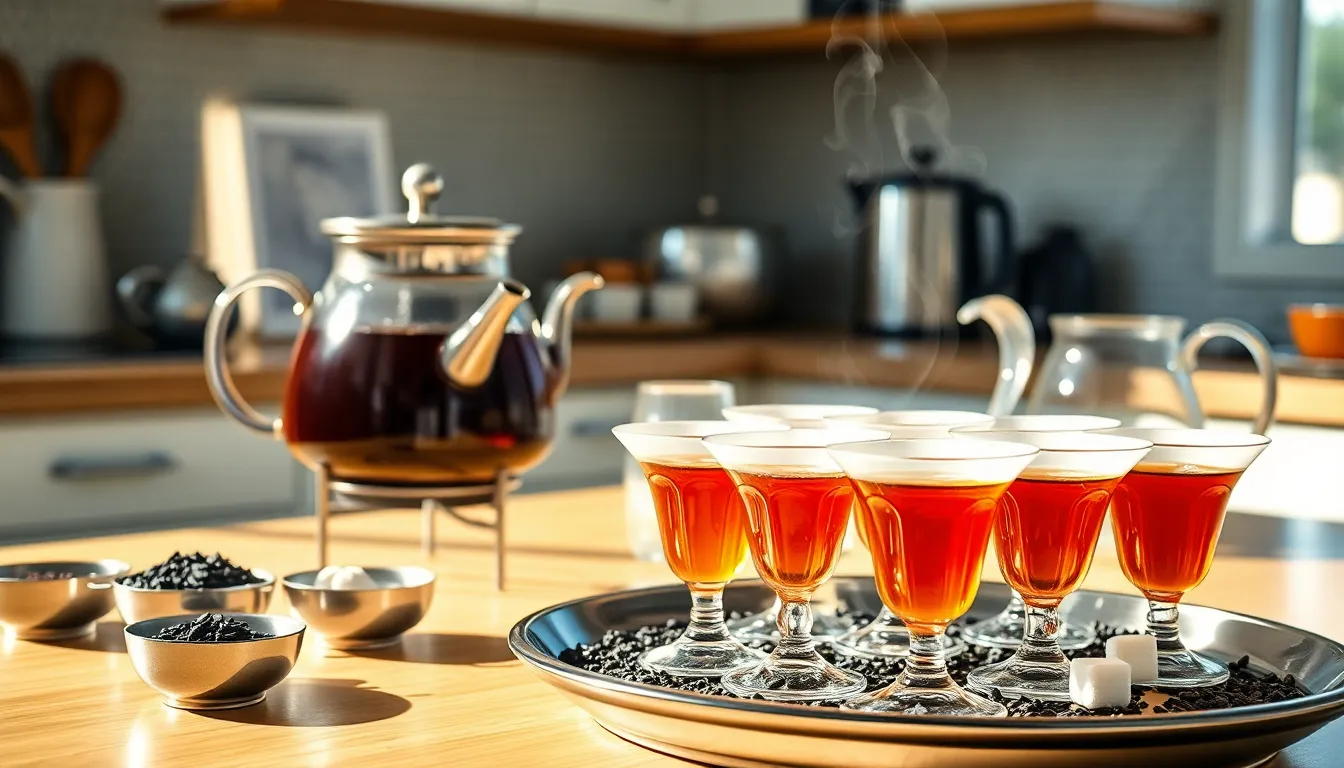
Turkish tea preparation benefits from strategic advance planning that enhances our brewing experience and ensures consistently perfect results. We can prepare several components ahead of time to streamline our daily tea ritual.
Tea Leaf Preparation
We should measure and portion our loose Turkish black tea leaves into small containers or tea caddies the night before. This advance preparation allows us to grab the exact 2-3 tablespoons needed without measuring during busy mornings. Store these pre-measured portions in airtight containers to preserve the tea’s aromatic oils and prevent moisture absorption.
Water Quality Setup
Fresh water quality significantly impacts our tea’s final taste. We recommend filling our çaydanlık’s lower pot with filtered water the evening before and covering it to prevent dust accumulation. This practice saves time during morning preparation and ensures our water reaches optimal temperature faster when we begin brewing.
Equipment Maintenance Schedule
| Task | Frequency | Time Required |
|---|---|---|
| Deep clean çaydanlık | Weekly | 15 minutes |
| Descale lower pot | Monthly | 30 minutes |
| Polish copper surfaces | Bi-weekly | 10 minutes |
| Replace tea filters | As needed | 2 minutes |
Regular maintenance prevents mineral buildup that affects heat distribution and tea flavor. We should establish a cleaning routine that keeps our equipment in peak condition.
Batch Brewing Strategy
Our çaydanlık’s design allows us to brew larger quantities that stay warm for extended periods. We can prepare a full pot in the morning that serves multiple cups throughout the day. The continuous gentle heat from the lower pot maintains optimal serving temperature for 3-4 hours without compromising taste quality.
Serving Preparation
We can arrange our tulip-shaped glasses and sugar cubes on serving trays before guests arrive. This advance setup creates an elegant presentation and allows us to focus on the brewing process rather than scrambling for serving essentials. Keep extra glasses warmed by rinsing them with hot water just before serving to maintain our tea’s ideal temperature.
Storage Instructions
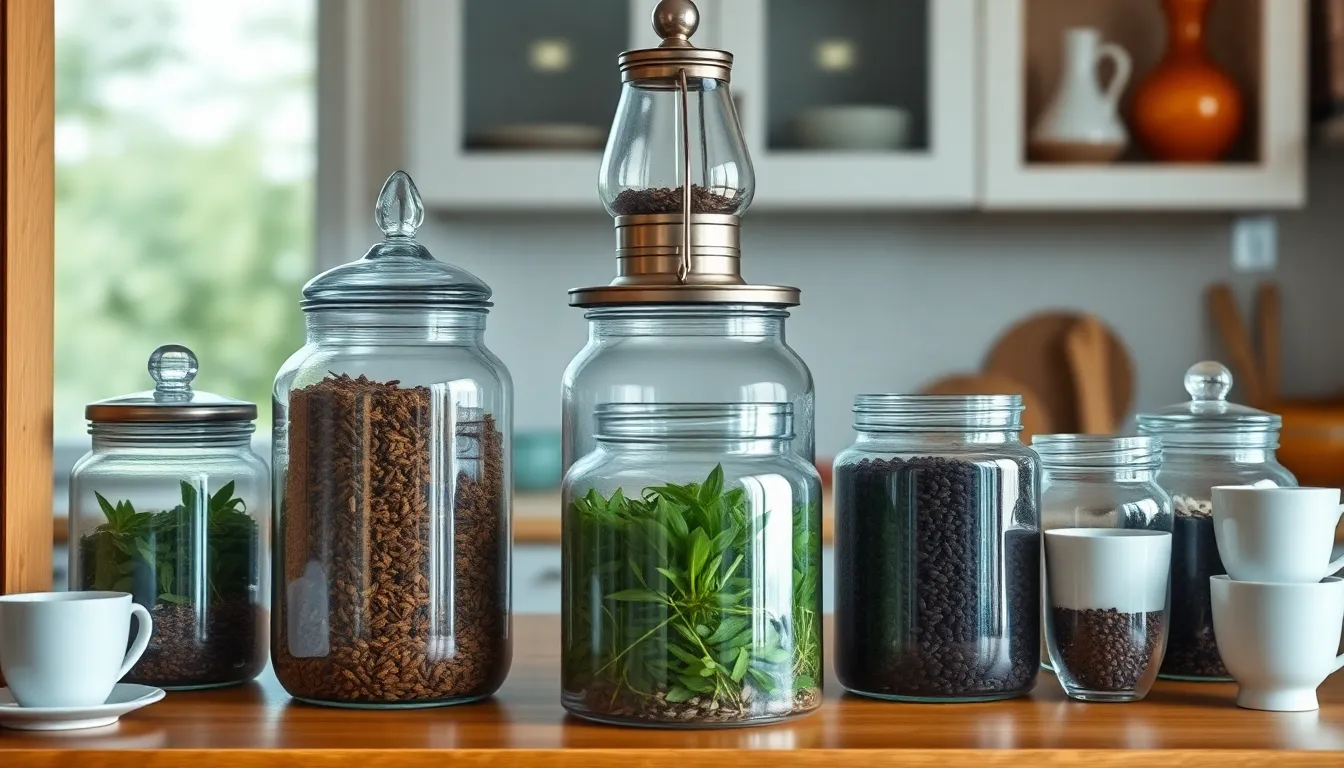
We must protect our Turkish tea leaves from elements that degrade their quality and authentic flavor. Our loose leaf Turkish black tea requires storage in a sealed container placed in a cool dark dry location away from heat light and moisture.
Protecting Tea Leaves Quality
Our tea container should remain in a kitchen cabinet or pantry where temperatures stay consistent. We avoid storing tea near stoves windows or other heat sources that can compromise the delicate flavor compounds. High humidity and direct sunlight will cause our precious tea leaves to lose their characteristic robust taste and aromatic properties.
Proper Container Selection
We choose airtight containers that prevent air exposure and maintain freshness. Glass jars with tight-fitting lids work exceptionally well for preserving our Turkish tea’s integrity. Metal tins with secure seals also provide excellent protection from environmental factors that can spoil our tea.
Brewed Tea Guidelines
Fresh Turkish tea delivers the best flavor experience we can achieve. We consume our brewed tea within 2 to 3 hours of preparation for optimal taste. Tea that sits longer becomes bitter and stale losing the smooth balanced character we worked to create through proper brewing techniques.
We never reheat Turkish tea that has been sitting on the stove. Reheating destroys the delicate flavor balance and creates an unpleasant bitter taste that masks the tea’s natural sweetness.
Tea Equipment Storage
Our Turkish tea set requires careful storage to maintain its functionality and appearance. We wrap each delicate porcelain or glass piece individually in soft acid-free tissue or cloth to prevent scratches and chips during storage.
We store our çaydanlık and glasses in a secure dry location protected from sudden temperature changes. Overcrowding storage spaces can lead to damage so we provide adequate space between pieces.
Maintaining Authentic Flavor
We dedicate our tea kettle exclusively to Turkish tea preparation. Using the same kettle for other beverages or different tea types causes unwanted odors to absorb into the metal which spoils our authentic Turkish tea taste.
Regular cleaning of our çaydanlık prevents mineral buildup and residual flavors from affecting future batches. We rinse thoroughly after each use and perform deep cleaning weekly to maintain optimal brewing conditions.
Variations of Turkish Tea
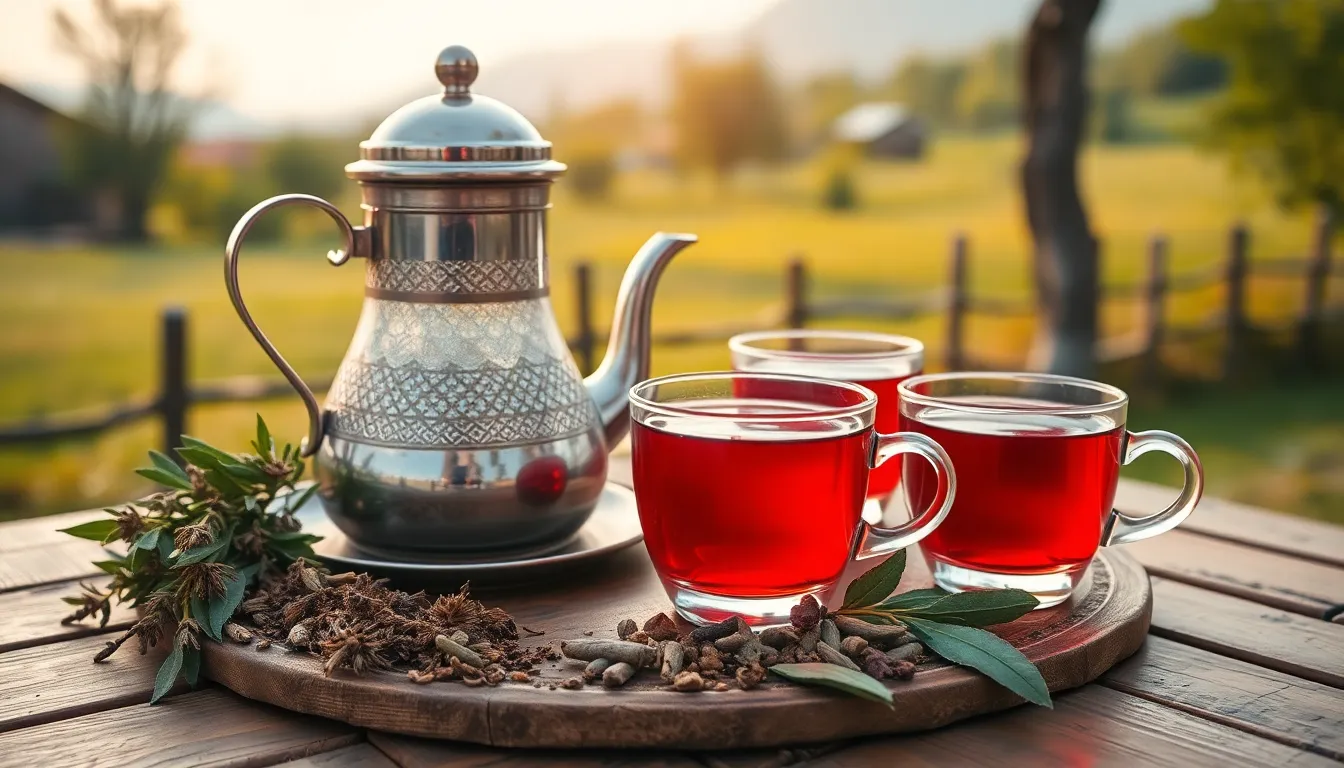
Turkish tea culture extends far beyond the traditional black tea brewing method. We discover a rich industry of herbal and fruit teas that reflect Turkey’s diverse regional preferences and agricultural abundance.
Apple Tea (Elma Çayı)
Apple tea represents one of Turkey’s most beloved fruit teas that we often serve to travelers and visitors. This black sweetened tea features a distinctive apple flavor that creates a refreshing drinking experience throughout the day.
We prepare apple tea using a base of black tea leaves combined with natural apple flavoring. The tea maintains its characteristic dark color while delivering a sweet and fruity taste profile that appeals to both locals and tourists.
| Apple Tea Benefits | Details |
|---|---|
| Vision support | Helps maintain healthy eyesight |
| Immune system boost | Strengthens body’s natural defenses |
| Refreshing taste | Provides pleasant fruity flavor |
The brewing process for apple tea follows traditional Turkish methods using the çaydanlık system. We steep the apple-flavored black tea in the upper kettle while maintaining hot water in the lower compartment for dilution.
Sage Tea (Adaçayı)
Sage tea stands as one of Turkey’s most treasured herbal teas that we prepare from dried sage leaves. This traditional medicinal tea offers therapeutic properties that Turkish families have valued for generations.
We brew sage tea by steeping dried sage leaves in hot water for 5-7 minutes. The resulting amber-colored tea delivers an earthy and slightly bitter flavor with aromatic herbal notes.
Turkish households rely on sage tea for its proven health benefits. The tea soothes throat irritation and supports digestive health naturally. We often serve sage tea after meals to aid digestion or during illness to provide comfort.
The preparation method differs from traditional black tea brewing. We use a standard teapot or cup to steep sage leaves directly in hot water rather than the double-kettle system.
Regional Variations
Regional preferences across Turkey showcase the country’s diverse tea culture that we observe in different provinces. Each region contributes unique flavors and brewing traditions based on local flora and cultural influences.
Rize Province serves as Turkey’s tea production heartland where we source the highest quality black tea consumed nationwide. The region’s Black Sea climate creates ideal growing conditions for robust Rize tea varieties.
| Regional Tea Preferences | Location | Tea Type |
|---|---|---|
| Rize çayı (Black tea) | Rize Province | Traditional black tea |
| Yarrow tea | Eastern Anatolia | Herbal medicinal tea |
| Sage tea | Aegean Region | Herbal digestive tea |
Eastern Anatolia and Aegean Regions favor herbal teas that reflect their mountainous terrain and Mediterranean influences. We find yarrow tea popular in Eastern Anatolia for its medicinal properties while the Aegean region embraces sage tea traditions.
Local tea preferences often incorporate indigenous plants and herbs that grow naturally in each region. These variations demonstrate how Turkish tea culture adapts to local ingredients while maintaining traditional brewing methods and serving customs.
Tips for Perfect Turkish Tea
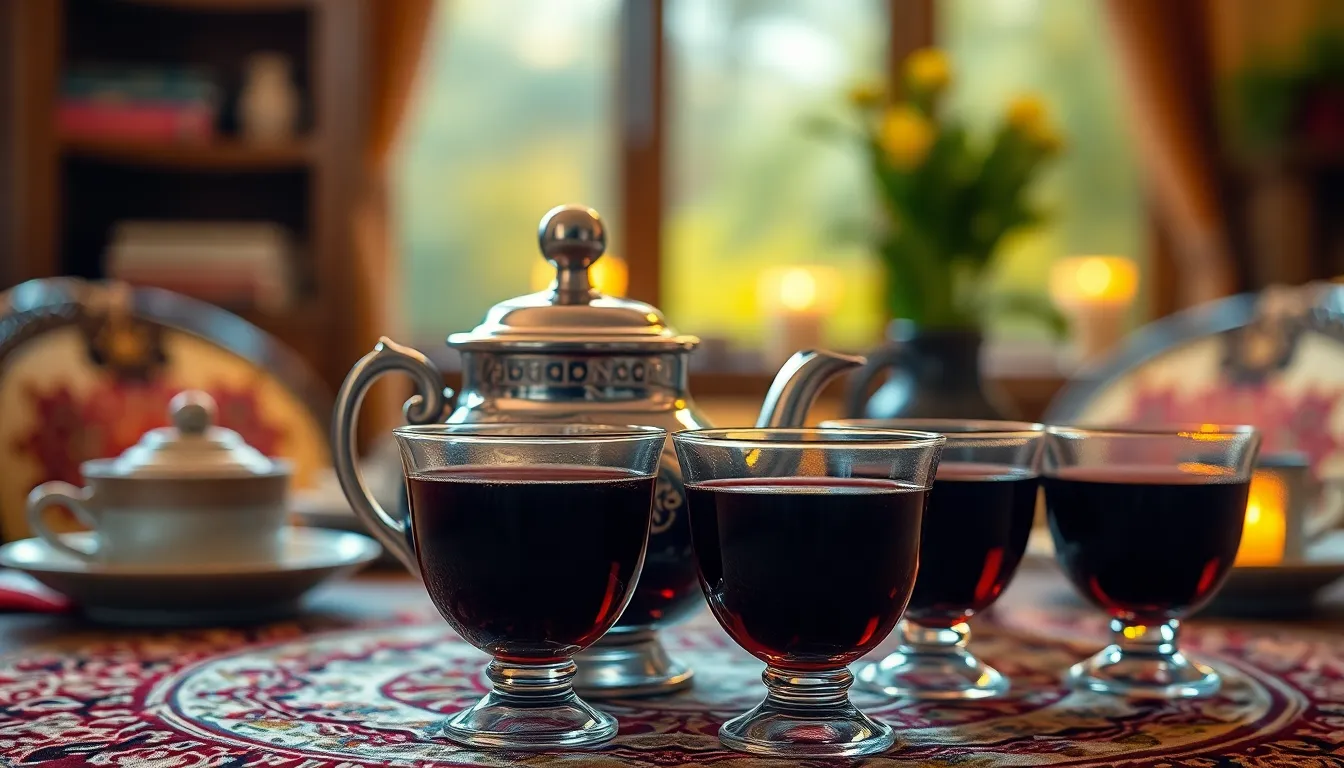
Mastering the art of Turkish tea requires attention to exact techniques that elevate this beloved beverage from ordinary to exceptional. We’ve gathered these essential tips to help you achieve the authentic flavor and presentation that Turkish tea deserves.
Start with Quality Ingredients
Fresh filtered water forms the foundation of outstanding Turkish tea. We recommend using high-quality Turkish black tea leaves, particularly those sourced from the renowned Rize region along the Black Sea coast. These leaves develop their robust character in Turkey’s unique climate and contribute the authentic flavor profile that distinguishes true Turkish tea.
Master the Proper Proportions
Achieving the perfect strength requires precise measurements. We suggest using approximately one teaspoon of tea leaves per two small cups of tea you plan to serve. For a full upper teapot in your çaydanlık, measure 2 to 3 tablespoons of loose leaf tea. This ratio ensures you can create both strong and mild servings to suit different preferences.
Perfect Your Steeping Technique
Time becomes crucial during the steeping process. We allow the tea to steep for 10 to 20 minutes in the upper pot to extract optimal flavor and achieve that characteristic deep color. Rushing this process compromises the tea’s complexity and diminishes its authentic taste. The double boiling method maintains consistent temperature throughout steeping, preventing the bitter notes that occur with overheated brewing.
Maintain Optimal Temperature
Keeping your tea hot throughout service requires strategic temperature management. We use the çaydanlık’s design to maintain warmth, with the lower pot’s gentle heat preserving the upper pot’s temperature. Electric tea makers with “Keep Warm” functions provide modern convenience while achieving similar results. Never allow the tea to cool completely before serving, as reheating compromises flavor integrity.
Customize Strength Properly
Turkish tea’s beauty lies in its adaptability to individual tastes. We fill tulip-shaped glasses one-third to half full with the concentrated tea from the upper pot, then dilute with hot water from the lower pot. This technique allows each person to achieve their preferred strength while maintaining the tea’s temperature and character.
Serve Authentically
Traditional serving enhances the overall experience. We avoid adding milk, which masks Turkish tea’s distinctive flavor profile. Sugar cubes or lemon slices remain optional additions that complement rather than overpower the tea’s natural taste. The tulip-shaped glasses not only provide cultural authenticity but also concentrate the tea’s aroma and maintain optimal drinking temperature.
Common Mistakes to Avoid
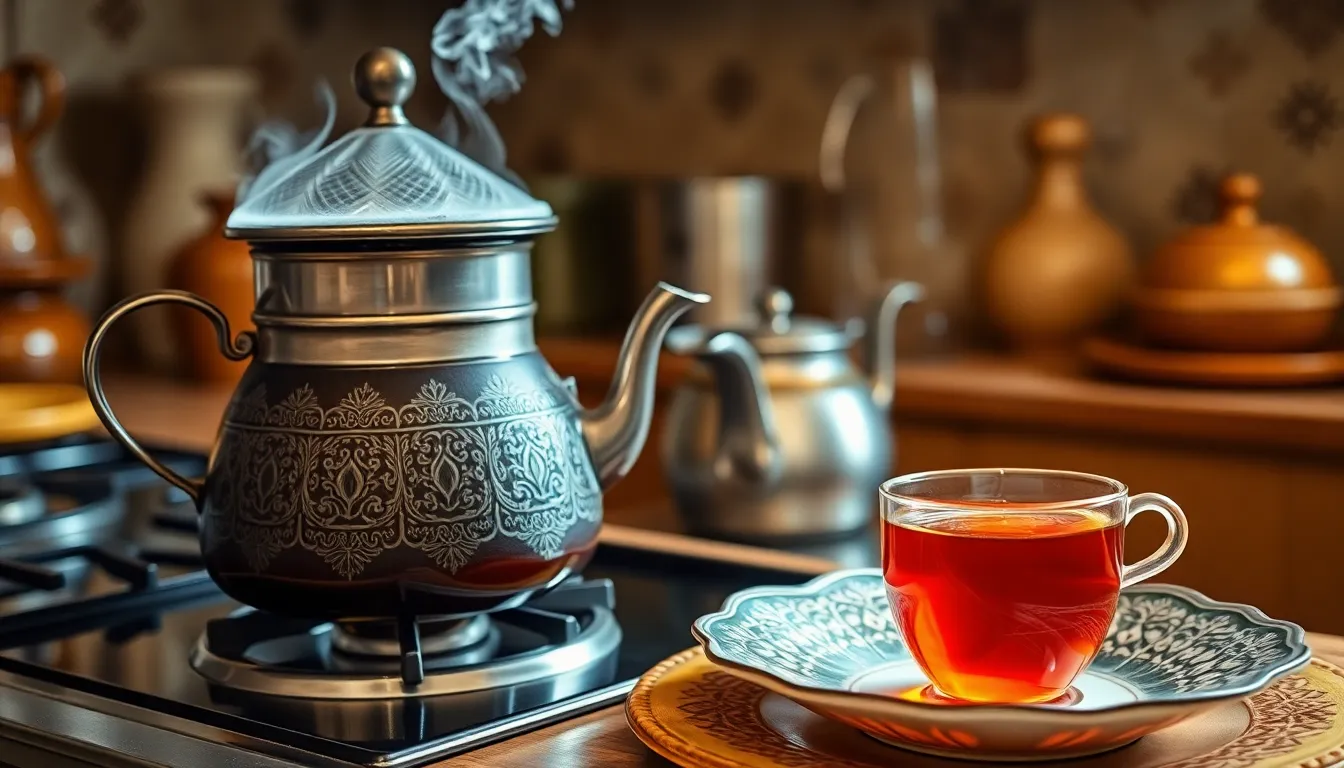
Even seasoned tea enthusiasts can stumble when preparing authentic Turkish tea. We’ve identified the most critical errors that can compromise your brewing success and the simple corrections that will elevate your çay experience.
Using Wrong Tea Leaves
Quality forms the foundation of exceptional Turkish tea. Many home brewers reach for convenient tea bags or settle for low-grade loose leaves that lack the robust character essential to authentic çay. We recommend investing in high-quality loose-leaf black tea specifically sourced from Turkey’s Black Sea region. Premium Rize tea leaves deliver the deep flavor profile that distinguishes genuine Turkish tea from ordinary black tea varieties.
Incorrect Brewing Technique
Patience transforms good tea into extraordinary tea. Rushing the brewing process or cutting short the steeping time produces weak and flavorless results that disappoint both the brewer and guests. We always allow our tea to infuse for at least 15 minutes to achieve the strong and aromatic character that defines Turkish tea culture. This extended steeping period enables the tea leaves to release their full flavor potential and creates the signature intensity that makes Turkish tea so beloved.
Incorrect Heat Application
Direct heat destroys the delicate balance that makes Turkish tea special. Placing the small teapot directly on the stove creates harsh temperatures that spoil both the tea’s color and taste profile. We consistently use the traditional two-tiered çaydanlık system that protects the tea from direct heat exposure. The lower kettle boils water while the upper teapot gently steams the tea leaves using indirect heat that preserves their subtle characteristics.
Water Quality Issues
Water quality dramatically impacts the final cup quality in ways many brewers overlook. Tap water often contains minerals and chemicals that interfere with the tea’s natural flavor development and create off-tastes that mask the tea’s inherent character. We always choose distilled or high-quality bottled water when preparing Turkish tea. This simple switch produces a richer and smoother taste that allows the tea’s authentic flavors to shine through without interference.
Serving Style Errors
Presentation matters as much as preparation in Turkish tea culture. Serving this traditional beverage in regular cups or mugs disrupts both the temperature control and visual appeal that enhance the drinking experience. We traditionally serve Turkish tea in small tulip-shaped glasses called çay bardağı that keep the tea warm longer and display its beautiful amber color. These specialized glasses aren’t just decorative choices but functional tools that optimize both the thermal properties and aesthetic presentation of properly brewed çay.
Adding Unconventional Ingredients
Cultural authenticity requires respecting traditional preparation methods that have evolved over centuries. Adding milk to Turkish tea represents a fundamental misunderstanding of this beverage’s character and completely alters its intended flavor profile. We serve Turkish tea plain or sweetened only with sugar cubes that complement rather than compete with the tea’s natural taste. Milk masks the subtle notes and robust character that make Turkish tea distinctive from other tea traditions around the industry.
Conclusion
Turkish tea represents far more than just a beverage—it’s a gateway to understanding Turkey’s rich cultural heritage and hospitality traditions. We’ve explored every aspect from selecting quality Rize tea leaves to mastering the traditional çaydanlık brewing method that creates that perfect amber hue.
The beauty of Turkish tea lies in its simplicity and precision. With the right equipment proper technique and attention to detail you can recreate this authentic experience in your own home. Remember that patience during the brewing process and using quality ingredients will always yield the best results.
Whether you’re sharing tea with friends or enjoying a quiet moment alone this timeless tradition connects us to generations of tea lovers who’ve perfected this create. The distinctive tulip-shaped glasses warm hospitality and rich flavors make Turkish tea an unforgettable experience worth mastering.
Frequently Asked Questions
What is a çaydanlık and why is it important for Turkish tea?
A çaydanlık is a traditional two-tiered Turkish tea brewing system consisting of two stacked kettles. The bottom kettle boils water while the top one steeps the tea leaves. This design allows precise control over tea strength and temperature, creating the perfect balance between strong and smooth flavors that defines authentic Turkish tea.
What type of tea leaves should I use for authentic Turkish tea?
For authentic Turkish tea, use high-quality loose-leaf black tea from Turkey’s Rize region in the Black Sea area. These tea leaves are specifically cultivated for their robust flavor and deep color. Use 2-3 tablespoons of loose leaf tea for optimal brewing results.
How do I achieve the perfect color for Turkish tea?
The ideal Turkish tea should have a deep reddish-brown hue, often described as “rabbit’s blood” color. Achieve this by using the proper tea-to-water ratio in your çaydanlık system and allowing adequate steeping time. The concentrated tea from the top kettle creates this characteristic rich color.
What are the traditional glasses used for serving Turkish tea?
Turkish tea is served in distinctive tulip-shaped glasses called “çay bardağı.” These glasses enhance the tea’s aroma, maintain optimal temperature, and showcase the beautiful reddish-brown color. They’re an essential part of the authentic Turkish tea experience and cultural presentation.
Can I add milk or lemon to Turkish tea?
Traditional Turkish tea is never served with milk or lemon, as these additions would mask the tea’s unique robust flavor. Instead, serve with sugar cubes on the side, allowing each person to sweeten their tea according to preference while preserving the authentic taste.
How should I store Turkish tea leaves to maintain quality?
Store Turkish tea leaves in airtight containers kept in cool, dark places away from heat, moisture, and direct sunlight. Proper storage maintains the tea’s flavor and quality for extended periods. Avoid storing near spices or strong-smelling items that could affect the tea’s taste.
What are some popular variations of Turkish tea?
Popular Turkish tea variations include apple tea (Elma Çayı), a sweetened black tea with apple flavor, and sage tea (Adaçayı), an herbal tea with medicinal properties. Different regions across Turkey also favor various herbal teas like yarrow, maintaining traditional brewing methods while offering diverse flavors.
How long should I steep Turkish tea for optimal flavor?
Turkish tea should steep for approximately 10-15 minutes in the çaydanlık system. The tea leaves remain in the top kettle throughout this process, creating a concentrated brew that can be diluted with hot water from the bottom kettle according to individual strength preferences.
Can I prepare Turkish tea without a çaydanlık?
While a çaydanlık is traditional and preferred, you can use alternative equipment like electric tea makers or standard teapots. However, the authentic double-brewing method and precise temperature control that makes Turkish tea special are best achieved with the traditional çaydanlık system.
What common mistakes should I avoid when making Turkish tea?
Avoid using low-quality tea bags instead of loose leaves, applying direct heat to tea leaves, insufficient steeping time, and poor water quality. Also, don’t reheat brewed tea as it compromises flavor. Always use the proper çaydanlık technique and serve in traditional tulip-shaped glasses for the best experience.







